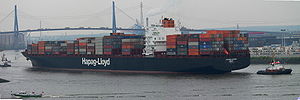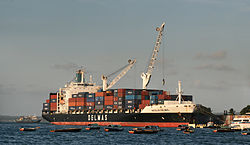- Cargo ship
-
 The Colombo Express, one of the largest container ships in the world (when she was built in 2005), owned and operated by Hapag-Lloyd of Germany
The Colombo Express, one of the largest container ships in the world (when she was built in 2005), owned and operated by Hapag-Lloyd of Germany
A cargo ship or freighter is any sort of ship or vessel that carries cargo, goods, and materials from one port to another. Thousands of cargo carriers ply the world's seas and oceans each year; they handle the bulk of international trade. Cargo ships are usually specially designed for the task, often being equipped with cranes and other mechanisms to load and unload, and come in all sizes. Today, they are almost always built of welded steel, and with some exceptions generally have a life expectancy of 25 to 30 years before being scrapped.[citation needed]
Contents
Types
Cargo ships/freighters can be divided into four groups, according to the type of cargo they carry. These groups are:
- General Cargo Vessels
- Tankers
- Dry-bulk Carriers
- Multipurpose Vessels
General Cargo Vessels carry packaged items like chemicals, foods, furniture, machinery, motor vehicles, footwear, garments, etc.
Tankers carry petroleum products or other liquid cargo.
Dry Bulk Carriers carry coal, grain, ore and other similar products in loose form.
Multi-purpose Vessels, as the name suggests, carry different classes of cargo – e.g. liquid and general cargo – at the same time.
Specialized types of cargo vessels include container ships and bulk carriers (technically tankers of all sizes are cargo ships, although they are routinely thought of as a separate category). Cargo ships fall into two further categories that reflect the services they offer to industry: liner and tramp services. Those on a fixed published schedule and fixed tariff rates are cargo liners. Tramp ships do not have fixed schedules. Users charter them to haul loads. Generally, the smaller shipping companies and private individuals operate tramp ships. Cargo liners run on fixed schedules published by the shipping companies. Each trip a liner takes is called a voyage. Liners mostly carry general cargo. However, some cargo liners may carry passengers also. A cargo liner that carries 12 or more passengers is called a combination or passenger-cum-cargo line.
History
The earliest records of waterborne activity mention the carriage of items for trade; the evidence of history and archaeology shows the practice to be widespread by the beginning of the 1st millennium BC. The desire to operate trade routes over longer distances and at more seasons of the year motivated improvements in ship design during the Middle Ages.
Before the middle of the 19th century, the incidence of piracy resulted in most cargo ships being armed, sometimes quite heavily, as in the case of the Manila galleons and East Indiamen. This sometimes resulted in the ships being escorted.
Piracy
Piracy is still quite common in some waters, particularly in the Malacca Straits, a narrow channel between Indonesia and Singapore / Malaysia, and cargo ships are still commonly targeted. In 2004, the governments of those three nations agreed to provide better protection for the ships passing through the Straits. The waters off Somalia and Nigeria are also prone to piracy, while smaller vessels are also in danger along parts of the South American, Southeast Asian coasts and near the Caribbean Sea.[1][2]
Definitions
The words cargo and freight have become interchangeable in casual usage. Technically, "cargo" refers to the goods carried aboard the ship for hire, while "freight" refers to the compensation the ship or charterer receives for carrying the cargo.
Generally, the modern ocean shipping business is divided into two classes:
- Liner business: typically (but not exclusively) container vessels (wherein "general cargo" is carried in 20 or 40-foot "boxes"), operating as "common carriers", calling a regularly published schedule of ports. A common carrier refers to a regulated service where any member of the public may book cargo for shipment, according to long-established and internationally agreed rules.
- Tramp-tanker business: generally this is private business arranged between the shipper and receiver and facilitated by the vessel owners or operators, who offer their vessels for hire to carry bulk (dry or liquid) or break bulk (cargoes with individually handled pieces) to any suitable port(s) in the world, according to a specifically drawn contract, called a charter party.
Larger cargo ships are generally operated by shipping lines: companies that specialize in the handling of cargo in general. Smaller vessels, such as coasters, are often owned by their operators.
Vessel prefixes
A category designation appears before the vessel's name. Naval ships, for example, have "USS" (United States Ship), "HMS" (Her/His Majesty's Ship), "HTMS" (His Thai Majesty's Ship). Merchant ships may have "RMS (Royal Mail Ship, usually a passenger liner), "MV" (Motor Vessel, powered by Diesel). "SS" (Steam Ship, now seldom seen, powered by steam). "TS", sometimes found in first position before a merchant ship's prefix, denotes that it is a Turbine Steamer. (For further discussion, see Ship prefixes.)
Famous cargo ships include the Liberty ships of World War II, partly based on a British design. Liberty ship sections were prefabricated in locations across the USA and then assembled by shipbuilders in an average of six weeks, with the record just over four days. These ships allowed the Allies to replace sunken cargo vessels at a rate greater than the Kriegsmarine's U-boats could sink them, and contributed significantly to the war effort, the delivery of supplies, and eventual victory over the Axis powers.
Lake freighters built for the Great Lakes in North America differ in design from "salties" because of the difference in wave size and frequency in the lakes. A number of these boats are so large that they cannot leave the lakes because they do not fit into the locks on the Saint Lawrence Seaway.
Sizes of cargo ships
Cargo ships are categorized partly by capacity, partly by weight, and partly by dimensions (often with reference to the various canals and canal locks they fit through). Common categories include:
- Dry Cargo
- Small Handy size, carriers of 20,000 long tons deadweight (DWT)-28,000 DWT
- Handy size, carriers of 28,000-40,000 DWT
- Seawaymax, the largest size that can traverse the St Lawrence Seaway
- Handymax, carriers of 40,000-50,000 DWT
- Panamax, the largest size that can traverse the Panama Canal (generally: vessels with a width smaller than 32.2 m)
- Capesize, vessels larger than Panamax and Post-Panamax, and must traverse the Cape of Good Hope and Cape Horn to travel between oceans
- Wet Cargo
- Aframax, oil tankers between 75,000 and 115,000 DWT. This is the largest size defined by the average freight rate assessment (AFRA) scheme.
- Suezmax, the largest size that can traverse the Suez Canal
- VLCC (Very Large Crude Carrier), supertankers between 150,000 and 320,000 DWT.
- Malaccamax, the largest size that can traverse the Strait of Malacca
- ULCC (Ultra Large Crude Carrier), enormous supertankers between 320,000 and 550,000 DWT
See also
References
External links
- Wikitravel - Freighter travel
- Vessel size groups
- Cargo ship: general structure and arrangement by Picture
Modern merchant ships Dry cargo Tankers Passenger Cargo liner · Cruiseferry · Cruise ship · Ferry · Narrowboat · Ocean liner · RORO ship · Train ferrySupport Other Pipe-laying ship · Cable layer · Crane vessel · Dredger · Drillship · Fishing vessel · Icebreaker · Merchant submarine · Narco submarine · Research vessel · Riverboat · Semi-submersible · SnagboatCategories:- Ship types
- Shipping
- Cargo ships
Wikimedia Foundation. 2010.


